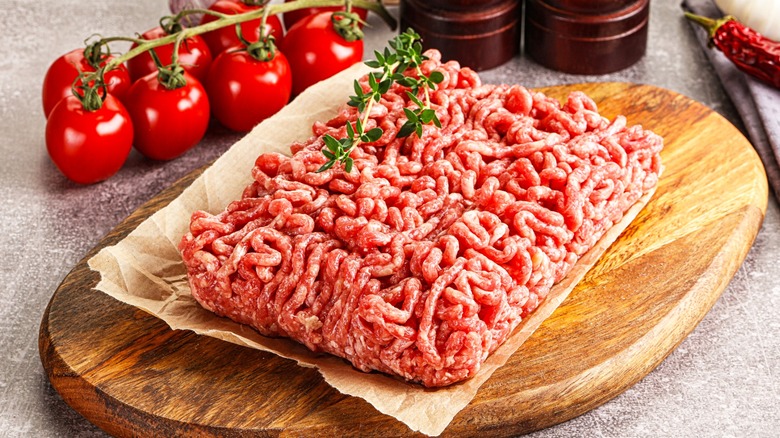Trust Us, You'll Want To Check The Color Of Ground Beef Before Buying It
Anyone who has ever become ill after eating a cheeseburger knows it is a memorable experience in the worst possible way. We reached out to the recent winner of the American River Burger Battle, chef Sam Shafer, for some insight on what to look for when shopping for ground beef, in order to avoid having a bad time after a cookout. The executive chef of Revival at The Sawyer offered some sage advice, and it all begins with trusting your eyes.
"The color should be bright red, though it is not uncommon to have some browning on the inside," Shafer said. A little bit of brown or gray color in ground beef is okay, but if that unappealing hue is completely covering the outer surface of the meat, that's a sign it shouldn't be in your shopping cart (and probably shouldn't be for sale in the first place, honestly). Beyond color, your eyes can clue you into other signs that ground beef may be past its prime.
"Be sure that there are no tears, excess liquid (especially brown) or a slimy appearance," Shafer added. "Further, I would not buy any ground beef past its 'sell-by' date." A "sell-by" date is more of a tip-off that food is approaching its last days than it is a trustworthy indicator of safety, but it's best not to press your luck if something past that date is available for sale. Still, if you just couldn't pass up that screaming deal on ground beef that looked questionable, be sure to use your other senses when you get it home to ward off the potentially agonizing symptoms of food poisoning.
With ground beef, the nose knows
Okay, so you took a shot on lean ground beef for a top-notch meatloaf, or one of those old-school forgotten ground beef dishes like picadillo, that didn't look so great. I get it, some deals seem too good to pass up. But before you go whipping up your culinary masterpiece, make sure the meat passes the smell test. As Sam Shafer pointed, "Ground beef should also have a mild metallic smell." If you catch a whiff of ammonia, or the protein smells rancid, don't take any chances. Your sense of touch can also clue you into the condition of ground beef. "It should have firm texture and break apart easily," Shafer noted. If it feels sticky and handles like Play-Doh, that's a telltale sign that the meat is beginning to spoil.
Using your other senses to double-check the quality is crucial because some purveyors have some tricks up their sleeve to make ground beef look more appealing than it truly is. "There are some manufacturers that use techniques to enhance the appearance of meat to make it look fresher (more red) for longer," Shafer warned us. "A common method that is used is to replace the oxygen with carbon dioxide and nitrogen in the packaging." This is an example of modified atmosphere packaging. "It works as carbon monoxide binds to the protein responsible for the red color (myoglobin) and forms carboxymyoglobin, which is a stable, bright red pigment that lasts longer than the meat's natural red color would." It's considered to be safe to consume, and it may even increase the shelf life. However, it can prevent you from seeing whether the ground beef is going bad.

